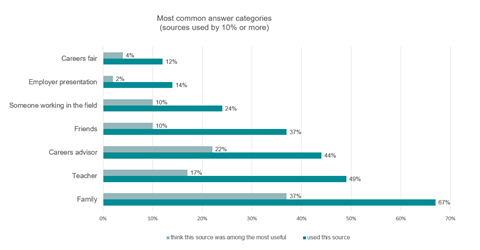Providing careers guidance isn’t natural territory for teachers, but with a little planning, including it in your lessons shouldn’t be difficult

There is a strong emphasis in the government’s career strategy on the use of the Gatsby Careers Benchmarks. The key benchmark for subject teachers is Benchmark 4: Linking curriculum learning to careers.
“All teachers should link curriculum learning with careers. STEM subject teachers should highlight the relevance of STEM subjects for a wide range of future career paths.
By the age of 14, every pupil should have had the opportunity to learn how the different STEM subjects help people to gain entry to, and be more effective workers within, a wide range of careers.”
In the benchmarks pilot in the North East, this benchmark was the one that most schools and colleges found hardest to implement. It’s easy to understand why: as a chemistry teacher, you are judged on how well your students do in chemistry, so taking time out of ‘subject content’ to include careers information can feel like you’re losing time for teaching.
However, I believe that there are good reasons for subject teachers to include careers in their classroom.
The first of these becomes clear when we look at where students get information, advice and guidance from. Families and teachers play a big part in supporting young people’s career choices. The Wellcome Trust regularly surveys a range of members of the public about attitudes to science and in 2013, they asked young people between the ages of 14 and 18 where they got their information, advice and guidance about careers from, and how useful they found that information. You can see from the diagram that, unsurprisingly, young peoples’ families were most commonly used, and most helpful. However, 49% of respondents said that they obtained careers information from their teachers, and for 17% of the young people this was among the most useful source of information.

Even if you don’t realise it, young people may be looking for careers information from you as their subject teacher.
Advice or information?
As a subject teacher, you might have some concerns about being asked to provide careers guidance to your students. You would not be alone. Watermeyer and colleagues interviewed 94 teachers about providing careers information and guidance and found that, although the majority of teachers recognised their role as being important, they were also concerned that they might provide biased, incorrect or out-of-date information.
Teachers are also not independent, and so a school which relied on teachers to provide guidance would not be meeting their statutory duty.
However, career choice is a process, and the more information and options that are presented to young people, the more likely they are to be able to identify a career which they would enjoy and succeed in.
Careers supporting chemistry learning
The second reason for including careers in the curriculum relates to the recent changes in the nature and structure of formal examinations, especially at GCSE. In current exams, there is more emphasis on questions which test application of knowledge (AO2) and evaluation (AO3), and they are often set in novel contexts: remember the furore in summer 2018 about AQA using carrots as a context for osmosis?
Using careers contexts to support chemistry teaching allows students to apply their understanding of key chemistry concepts in novel situations. When regularly presented with a context or a question that they have not met before, students will get more used to identify the underlying chemistry that they need to apply. I’ve written about one way to include careers in the curriculum using interesting photographs at the start or end of a lesson.
Planning for careers
However, whilst you might be able to think of career contexts to illustrate a chemistry topic in the middle of a lesson, it’s likely that you will be limited in what you include because you will be focusing on all the other things that go on in the classroom. Therefore, it makes more sense to plan ahead.
It’s also helpful if careers in the curriculum is tackled across a whole department rather than piecemeal in individual teacher’s classrooms. To do that, departments will need to use departmental planning time to identify links and include them in schemes of work/learning. Working together to identify real-life applications means that there will be a wider range of possible ideas. Including careers contexts doesn’t have to be an ‘every lesson’ activity, but including them in each topic will bring a greater richness to the curriculum.
- Talk to the careers lead in your school or college. They may already have information about local companies and industries that you can use. For each topic, identify a company that could make use of that topic in their business. For example, when teaching about water resources you could use the context of your local water company; for me that would be Northumbrian Water. NUSTEM at Northumbria University is developing a series of employer case studies that link the companies to subject topics and identify jobs that people in those companies have.
- Tap into the expertise of parents and families. Think about what careers links your students’ and their families already have and try to bring those into your teaching. The Science Capital Teaching approach provides some suggestions for exploring the science contexts that students might find in their local area and families.
- Use pre-prepared resources which are already set in a careers focused context, or create your own using news stories or local industries. For example, the Learn Chemistry website has a number of resources that could be used to introduce different careers into your teaching.
- The STEM Insight placement scheme provides an opportunity for education staff to experience life in industry – a bit like work experience for teachers. This can be a really good way to identify where those career links are, and helps you to gain confidence in talking about careers with their students.





![Shutterstock 130330691 300tb[1]](https://d1ymz67w5raq8g.cloudfront.net/Pictures/100x67/6/3/0/113630_shutterstock_130330691_300tb1.jpg)



No comments yet